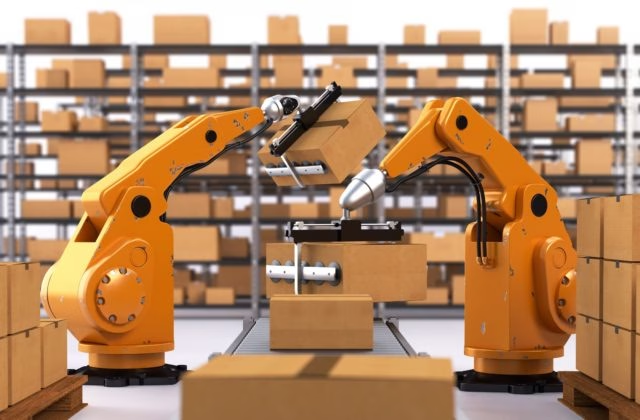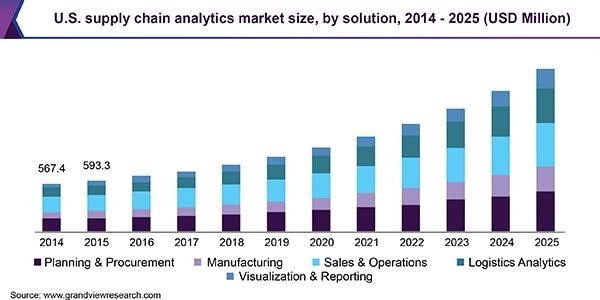
How To Automate Your Supply Chain?
Are you wondering how to automate your supply chain?
That’s an excellent market with many opportunities to make a mark.
According to a study done by Markets and Markets, "The supply chain analytics market size is expected to grow from USD 3.6 billion in 2018 to USD 7.1 billion by 2025, at a Compound Annual Growth Rate (CAGR) of 14.6% during the forecast period."
Other than the vast sums of money to be had, this industry segment has all the opportunities for companies to really revolutionize global industry. Here’re a few amazing case studies of companies who hired DevTeam.Space to build their supply chain products:
- Medical Supply - Healthcare Blockchain Supply Chain Software
- Neural Network Library - Machine Learning Application
- Property Ownership Software - Housing Ownership Verification Program
Contents
The growing market for supply chain automation solutions
The various approaches to implement supply chain automation solutions
Approach #1: Buy a supply chain automation software
Approach #2: Build a supply chain automation solution
Final thoughts
The growing market for supply chain automation solutions

Organizations of all sizes invest in software products for supply chain automation. The market for such software is growing significantly, as the following market research reports state:
- An Allied Market Research report projects that the global market for supply chain management software will grow from $10.850 billion in 2016 to $24.532 billion in 2025. This report projects a CAGR of 9.7% during the 2018-2025 period.
- Yet another report from Technavio projects a CAGR of 11% during 2020-2024 for the global supply chain management software market. This report estimates that this market will grow by $9.56 billion during this period.
The various approaches to implement supply chain automation solutions
How do you implement supply chain automation solutions in your organization? You have two alternatives, which are as follows:
- Buy a market-leading supply chain management (SCM) software;
- Build an SCM software in-house.
Both approaches have their share of pros and cons. Your choice depends on several factors and questions, e.g.:
- Business requirements: Do you have too many unique requirements? You may need to custom-build your SCM solution then. Conduct thorough feasibility and cost-benefit studies for your requirements though. Remember that market-leading SCM products typically address all key SCM functionalities.
- Gap analysis: Check out the leading SCM products in the market and analyze whether they meet your requirements. If this gap analysis reveals that none of the leading products meet your requirements, then revisit your requirements carefully! Check whether you are targeting too many ambitious and unique features.
- Security risk analysis: Check whether the leading SCM products meet your information security requirements. Remember to thoroughly analyze your security requirements. Building an SCM solution that’s more secure than a market-leading SCM product can be costly!
- Timeline: How quickly do you need to implement a supply chain automation software?
- The manpower availability for development and maintenance: Do you have enough competent people to develop a state-of-the-art SCM solution within your schedule and budget constraints? Can you get enough skilled people to maintain it?
- Budget: Building an SCM solution that provides more functional and non-functional features than market-leading SCM products can cost you significantly! Do you have that budget?
Our guide “Enterprise software: answering the build vs. buy dilemma” explains these factors in detail.
Approach #1: Buy a supply chain automation software
Assuming that you have opted to buy a supply chain automation software, the question is how to do it. You need to take the following steps:
1. Familiarize yourself with the different types of supply chain management software
Analyze the various types of supply chain management software you need. There are the following types of SCM software:
- Lean inventory tools: These tools utilize the popular methodology called “Lean” to reduce wasteful expenditure. You can decrease the need for warehouse space by using these tools, which reduces costs. You can also streamline the warehouse labor force.
- Shipping status tools: Shipping status tools provide real-time status updates about various shipments to customers, factories, warehouses, etc. Thanks to the alerts and updates from these tools, companies can remain well-informed about shipments. This helps them to act on situations that demand urgent actions.
- Order processing tools: These tools support key order processing functionalities, e.g., sales order processing, order management, order fulfillment, etc. Effective order processing tools reduce the time taken to manage these functions, which results in cost reduction.
- Demand forecasting tools: These tools use analytics and forecast the future demand for a product. You use this information for your effective manufacturing planning and reducing wasteful expenditure.
- Collaboration portal tools: These tools allow all stakeholders to get visibility to production progress, shipment history, purchase orders, order management, etc. Stakeholders in businesses can communicate issues concerning the supply chain using these tools.
Read “Five types of supply chain management tools” to learn more.
Note that this classification of the types of supply chain management software isn’t the only one. It’s an overarching classification.
Depending on SCM vendors bundle the features they offer, some classifications cite the following additional types of tools:
- Warehouse management tools;
- Specialized freight handling tools;
- Bid and spend tools;
- Supplier management tools;
- Analytics and reports;
- Transportation and logistics tools;
- Compliance and auditing tools.
Read more about them in “13 essential types of supply chain management tools”.
2. Select a supply chain automation product and implement it in your organization
You now need to select an appropriate supply chain automation product. Providers of leading SCM products publish detailed product guides and training materials. You need to work with them for the configuration of the product.
Additionally, you might need their help to train your employees and business partners. Plan and execute this implementation by following appropriate project management practices and processes.
You can evaluate the following leading SCM products and choose the one that fits your requirements:
- SAP SCM;
- Oracle SCM;
- JDA SCM;
- Infor SCM;
- Epicor SCM;
This isn’t an exhaustive list, and you can find more SCM products in “Top 15 supply chain management software”.
Approach #2: Build a supply chain automation solution
You need to undertake a complex software development project to build a supply chain automation solution. Such a project involves the following:
1. Define the project scope when you build a supply chain automation software
Your project scope includes several aspects, e.g.:
- What kind of apps you would offer, e.g., web app, mobile app, etc.;
- The features of the SCM solution you are building;
- The organizational divisions and geographies where you would deploy the SCM solution.
Hire a competent project manager (PM), an experienced software architect, and a team of knowledgeable business analysts (BAs). Include the following key features in your proposed SCM solution:
- Inventory management;
- Order management;
- Warehouse management;
- Shipping management;
- Forecasting and analytics;
- Supplier collaboration.
Read “Look for these 6 SCM software features to automate your supply chain and go global” to learn more about these features.
You could use the “Agile” methodology in this project, which helps with large-scale and complex transformation efforts like this. If you take the Agile route, then you might launch a “Minimum Viable Product” (MVP) first with minimal features. Based on the feedback from users, you could enhance the product further.
If you take this route, then you need to prioritize the features for your MVP. Do the following:
- Use a tool like the “Pain and gain map” to map the impact of the features;
- Prioritize the features using a tool like the “Prioritization matrix”.
Read our guide “5 tips to create a sleek MVP” for more insights.
2. Plan the project
Plan the project meticulously and cover the following aspects:
- Cloud infrastructure: Consider using a hybrid cloud since you would process sensitive data. Analyze which kind of cloud platforms you should use, e.g., “Platform-as-a-Service” (PaaS), “Mobile-Backend-as-a-Service” (MBaaS), etc.
- Security: An SCM solution would process sensitive data and you would need to comply with data security and privacy regulations. Plan to mitigate security vulnerabilities, use multi-factor authentication (MFA), encrypt data, and include compliance/security testing.
- Approach: Decide whether you will develop native mobile apps, where you will develop APIs, etc. Check our guide “What is the best development approach to guarantee the success of your app?” for more insights.
- Budget: Estimate iterations effectively and tie your budget allocation requests to tangible business value that you promise.
You also need to plan the project schedule, human resource management, risk management, communications management, quality management, etc.
3. Execute the supply chain automation solution development project
As part of project execution, do the following:
- Hire a competent team: Include roles like UI designers, web developers, mobile developers, testers, DevOps engineers, etc. Read our guide “How to find a good software developer” for help.
- Organize the team: Keep the team focused on delivering business value to stakeholders. Organize the team in a manner that fosters collaboration.
- Set up environments/tools: You need to set up development, testing, staging, and production environments. Establish an effective CI/CD pipeline and provide the required access to team members.
- Direct the team in alignment with the project schedule, budget, and quality objectives.
4. Monitor and control the project
Monitor the project by reviewing the following categories of metrics:
- Schedule adherence;
- Budget adherence;
- Business value delivered;
- Quality metrics.
Take corrective actions when you see deviations from schedule/budget/quality objectives.
Review the project risks and mitigate them proactively. Monitor the issues and resolve them. Report project status to relevant stakeholders. Read “Project monitoring and control” for more insights.
5. Close the project
Upon delivering the SCM product your team has built, you need to close the project. Do the following:
- Hand over the new SCM system to the maintenance team in your organization by following the agreed-upon transition plan. This could include your team supporting the system during the warranty period.
- Release the resources.
- Submit lessons-learned to the organizational knowledge repositories.
- Communicate project closure to all relevant stakeholders.
Final thoughts
In this article, we reviewed the various alternatives you can explore for supply chain automation in your organization. You can buy a market-leading SCM product or build one. We explained what you should do in both approaches. If you need help to develop a supply chain automation software, then please contact us at DevTeam.Space. We will promptly help!
Frequently Asked Questions
How To Automate Your Supply Chain?
Automating a supply chain requires developers skilled in creating software solutions for specific business processes and hardware. Read this article to find out more.
What are the advantages of automating my supply chain?
Reduction of staff required for everyday operations, faster supply chain, and other smaller benefits such as better accuracy, etc.
What developers do I need to automate my supply chain?
You will need expert developers who have experience in your specific industry. Developers with a good understanding of specific niches such as smart contracts is a big bonus.


